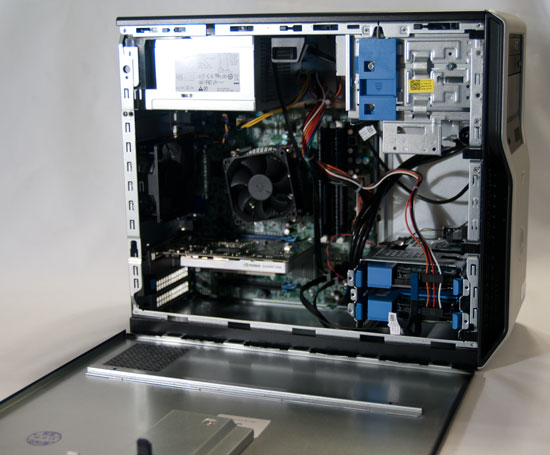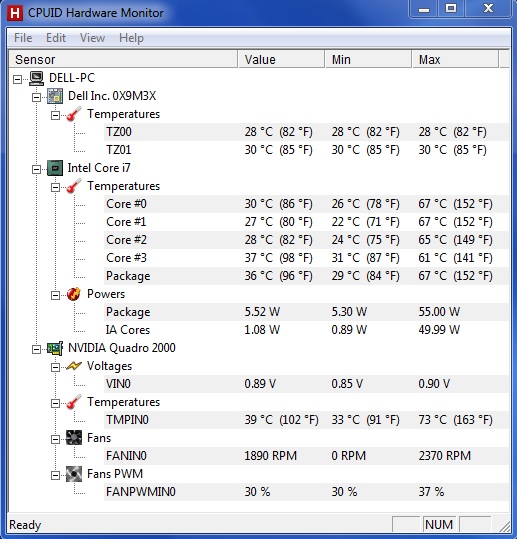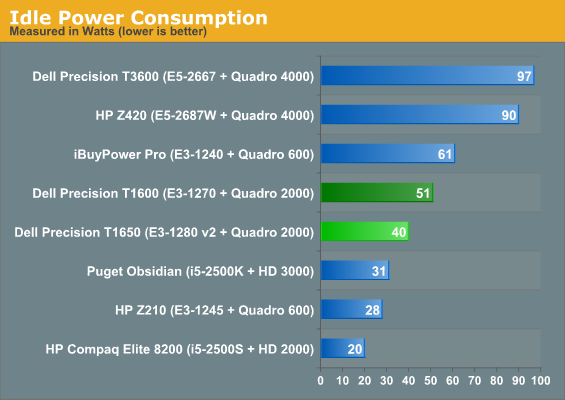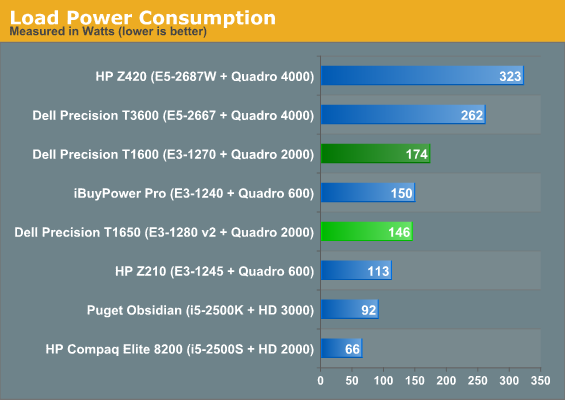Dell Precision T1650 Workstation Review: Ivy Bridge Xeons Bring Performance
by Dustin Sklavos on July 31, 2012 12:00 AM EST- Posted in
- Systems
- Dell
- Workstation
- Ivy Bridge
- Enterprise
Build Quality
Where I do think the Dell Precision T1650 betrays its entry level roots is in the build quality. It's hard not to be disappointed with the T1650 when the T3600 and its brethren have such a vastly superior design. In fact, this is where it's clear just how incremental the T1650's build really is.
.jpg)
So above, we have the interior of the T1650 with everything in its very standard ATX position. This isn't a bad design, necessarily, but I chastised HP for recycling the previous year's chassis with the Z420 and now it's Dell's turn. The front fascia may be different for the T1650, but...

The picture above is the last generation T1600. What's changed? They moved the I/O cluster and swapped out the fascia. That's all. That's it. Compared to the brilliant design decisions and language of the T3600 (seen below)...
.jpg)
...it's very hard not to be disappointed. This isn't a design that can't be shrunk down to suit the T1650, but hitting a price point seems to have been more important. As a result, you lose the smarter airflow and easily replaceable power supply. Worse, you're still stuck paying $50 for an upgrade to an 80 Plus Gold power supply, something that comes standard in the bigger models. HP ships their competing Z220 desktop with 80 Plus Gold power supplies standard.
This isn't a bad internal design, but it shows just how mild a refresh the T1650 winds up being. Something could've been done here to improve the product and it wasn't. Dell even has the price latitude to do so; HP's Z220 starts $400 more expensive (and indeed a comparable configuration to our review unit winds up being $300 more expensive), so why not take a small sliver out of that to deliver a more compelling product?
Noise, Heat, and Power Consumption
Whatever my disappointment with the aging internal design of the T1650, it's pretty tough to argue with the thermals, power, and acoustics. At idle the T1650 is beneath the noise floor of my sound meter (30dB), and even under load it only goes up to ~33dB. Is it a silent machine? No, but it's remarkably quiet and is going to be a perfectly fine citizen of any workplace.

Ivy Bridge may get hot in a hurry when overclocked, but as a workstation processor running at spec it's remarkably frosty. While I think the T1650's chassis still has room to improve thermals, a core peak of 67C under sustained load really isn't bad (especially when that core is peaking at 4GHz), and the Quadro 2000's 73C is perfectly reasonable for a GPU using a single-slot cooler.


Of course, the power consumption is where the T1650's new processor gets really exciting. The new Xeon helps it idle at just 40W, 11W lower than the outgoing E3-1270. That's a much faster processor pulling a lot less power under both idle and load. You'd basically have to get rid of the dedicated graphics hardware to get power consumption any lower, making the T1650 and its Ivy Bridge-based Xeon a very attractive option for offices looking to deploy a substantial number of workstations. The power consumption savings most definitely adds up.


_thumb.jpg)
_thumb.jpg)
_thumb.jpg)
_thumb.jpg)
_thumb.jpg)
_thumb.jpg)








38 Comments
View All Comments
secretmanofagent - Tuesday, July 31, 2012 - link
Perhaps I'm being naive, but why would you still include USB 2.0 ports if USB 3.0 is backwards compatible? The only thing I can think of is that they don't think four USB ports are enough, and I can maybe buy that, but it means the user has to think about which port they're going to plug into.Also, how is 8GB middle of the road for a workstation? I would think the minimum would be 16GB.
Has HP's reliability gotten any better? I've had horrible experiences with them, and our IT department isn't keen on them either.
aicom64 - Tuesday, July 31, 2012 - link
USB 3.0 is only backwards compatible at the hardware level. Without proper USB 3.0 drivers, the ports won't work at all, even in USB 2.0 mode. With Windows 8, I'd expect we'll start to see some motherboards with only USB 3.0, but for now we need some USB 2.0 ports just to get through installation to install the USB 3.0 drivers. On the Apple side, it's not a problem because the keyboard and trackpad are connected via internal USB 1.1 connection even though all external ports are USB 3.0.secretmanofagent - Tuesday, July 31, 2012 - link
Very interesting, I had no idea. Thanks for the reply.Robert Pankiw - Tuesday, July 31, 2012 - link
I know aicom64 posted a great answer, but I just enforce that with, my keyboard doesn't work at startup using USB 3.0, but on USB 2.0 it is fine, even though once I am in Windows, my keyboard works in either port. As aicom64 alluded to, issues (like that) will be solves in Windows 8.Braincruser - Tuesday, July 31, 2012 - link
In addition to that, adding 10 USB 3.0 instead of 4x 3.0 + 6x 2.0 can exhaust the internal bandwidth or will take up too much PCI-E links to operate, and on the other hand, only a few devices benefit from usb 3.0, mostly ones that are data storage and transfers like hard drives. there is no point connecting a mouse and a keyboard to a usb 3.0 when an inexpensive 2.0 will do just the same.augiem - Tuesday, July 31, 2012 - link
If your keyboard doesn't work before you get into Windows, having Windows 8 on your system won't solve anything. The Bios/UEFI would have to support it. Windows 8 preinstalled systems may have this requirement, I don't know, but certainly installing Win8 on your current PC won't help in that regard.softdrinkviking - Friday, August 3, 2012 - link
Yup. Except that I don't think any mobo companies will bother with usb 3.0 support in any bios. Bios is almost legacy, so they will probably focus on enabling it in UEFI only.IanCutress - Tuesday, July 31, 2012 - link
I would like to add, as I end up installing OSes on different Z77 motherboards every week, that sometimes the chipset USB 3.0 do work on install. I have a motherboard here now that has only USB 3.0 on the back panel, but enough of them work during a USB Win7 install to go through it until we can install the rest of the USB 3.0 drivers.Ian
bobj3832 - Tuesday, July 31, 2012 - link
USB 3 has separate transceivers for the USB 2 and 3 parts. USB2 uses 4 pins while USB3 uses 9 because it's the the 4 from USB2 plus 5 more. Another transceiver means more die space on the chip is used and more pins which increases cost.owned66 - Tuesday, July 31, 2012 - link
never ever buy from companies like thesethese desktops wont live long
the first thing that gonna die is the motherboard just look at it !